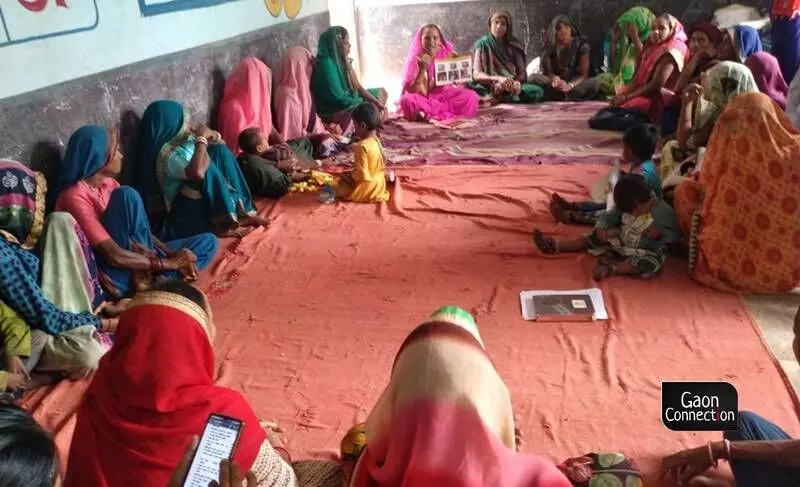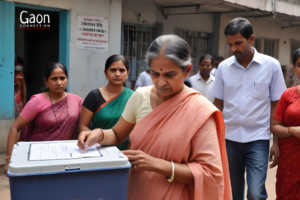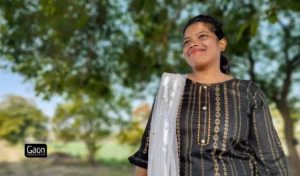Rama Kanoje, a 37-year-old resident of Matli village in Madhya Pradesh’s Barwani district, recalls the times when the local panchayat (village council) office was predominantly a men’s domain.
But that changed in 2018 when Kanoje was appointed as badlaav didi (a changemaker) which essentially enabled her to perform the role of a change vector in her village by connecting the rural residents with government’s frontline health workers commonly known as the ASHAs (Accredited Social Health Activists).
“Although I was a part of a sahaayta samooh [self help group] from 2015 and used to do silaayi ka kaam [seamstress], I didn’t see myself as an independent person who could help the village community. But three years later in 2018, when I was trained to help women access health services, it helped me develop a newfound belief in my ability to do some work for public good and it felt really good,” Kanoje told Gaon Connection minutes after attending a session of her training programme held at NRLM centre in Rajpur, 330 km from the state capital Bhopal.
Also Read: Madhya Pradesh: Rural learning centres help kids in Barwani stay in touch with education
“By being in regular contact with government agencies like anganwadi workers and panchayat officials, my knowledge of welfare schemes increased a lot and now my husband is able to get a loan to set up a small grocery store in the village. I find it empowering that I was able to help my husband in earning a livelihood,” she added.
Kanoje is amongst 168 women from 79 villages in Barwani district’s three clusters — Rajpur, Julwania, and Palsud, who have been trained to act as a bridge between the government’s healthcare support and the rural residents with a focus on women and children.
The training is provided by Chetna — a Ahmedabad-based non-governmental organisation (NGO), which is also a partner of Transform Rural India Foundation [TRIF] and National Rural Livelihood Mission (NRLM) in a poverty alleviation scheme implemented by the Union Ministry of Rural Development.
The management of the badlaav didi project is taken care of by the (TRIF) — a New Delhi-based NGO working to promote rural livelihoods across the country.
Also Read: ‘Rozgaar Kendras’ promote rural entrepreneurs in UP’s Aligarh
“TRIF tries to build the capacity of social assets like SHGs and village organisations to create community leaderships which then emerge as the change vectors. We put out a plan to encourage women to take matters in their hand. This is a volunteer-based initiative,” said Abhishek Gupta, Manager, TRIF of Rajpur block.
A PHC and nutrition awareness among major achievements
Among the major achievements of badlav didis in Matli village are the construction of a primary health centre [PHC] and awareness about iron deficiency amongst the village women.

It is learnt that these change vectors have also helped in activating Village Health, Sanitation and Nutrition Committee (VHSNC) and developing a health plan to fill in the gaps. They ensure that a plan is in place and is followed up on.
“I along with four other badlaav didis in my village, went to the panchayat office in 2019 and demanded that our village should have a hospital of its own as the nearest health centre [primary health centre] is almost 10 kilometres away,” Rama told Gaon Connection.
At present, the hospital is under construction and is scheduled to be open next year.
Another accomplishment achieved by the coordinated efforts of badlaav didis, the ASHA workers and the healthcare agencies in the village is the increased awareness about iron deficiency in the rural residents of Matli village. This has helped adolescent girls and pregnant women take better care of their health.
Revanti Kanoje, an 18-year-old who is presently carrying a pregnancy of four months, is one such woman.
“Earlier, I didn’t know that iron is important during pregnancy but Rama didi not only educated me about its vitality but also helps me in getting the goli [iron supplements],” the expecting mother told Gaon Connection.
Volunteering without financial rewards
Earlier the lives of badlaav didis were limited to ‘ghar se khet, khet se ghar’ [from home to agricultural field and back] but now they attend to their her household chores, then look after the fields and also lead many meetings at the gram sabha.
Gupta, the block level functionary of the TRIF shared with Gaon Connection that when the project had started in 2018, initially there was reluctance amongst the women to take up the role of badlaav didis both due to lack of financial compensation as well as social limitations for women to step out of their households for such work.
“But after being educated on the long term impacts and how this will help them in availing other schemes in a better way has convinced them to actively pursue this work,” Gupta added.

The management of the badlaav didi project is taken care of by the Transform Rural India Foundation (TRIF) — a New Delhi-based NGO working to promote rural livelihoods across the country.
The sheer joy of feeling empowered makes these women volunteers as badlaav didis despite there are no financial rewards for their service.
The NGO functionary added that audio-visual means are used to ensure information, education and communication (IEC) to train the women for taking up the responsibilities of badlaav didis.
“Many women were anaemic in these villages but these health change vectors have been actively visiting the community to cook food in iron pans, asking to resort to tiranga thali to maintain nutritional balance,” he added.
He further stated that the ASHAs are mostly overburdened by immunisation drives and other rural healthcare campaigns and these badlaav didis have helped them share some of the burden.

Among the major achievements of badlav didis in Matli village are the construction of a government hospital and awareness about iron deficiency amongst the village women.
It is learnt that these change vectors have also helped in activating Village Health, Sanitation and Nutrition Committee (VHSNC) and developing a health plan to fill in the gaps. They ensure that a plan is in place and is followed up on.
Also, Usama Khan from Chetna NGO accepted that few aspects of healthcare support still need sustained efforts to produce better results.
“Palsud cluster still witnessed child births at homes due to no road connectivity. I have also been told that the nurses’ behaviour towards female patients in government hospitals is a bit rough. There are continuous efforts to target such problems,” he said.
Khan pointed out that the villagers have a far better relationship with the badlaav didis as compared to ASHA workers.
“I even talk to women about health awareness when I attend any shaadi-byah [marriage ceremonies],” Rama said.
Badlaav Didis support ASHA workers
Rama coordinates with Gomti Kanoje, the ASHA in her village and helps her identify the malnutritioned children while taking stock of the health emergencies. The roles of ASHA and badlaav didis are mutually agreeable to ensure efficient coordination.
Joshma Kanoje, a 35-year-old badlaav didi in the same village also explained why she volunteers despite the lack of financial rewards for her work.
“Maybe they don’t pay us for this, but our active involvement has helped us avail other schemes, it has been impacting our livelihood in many ways. I think it’s not about money, if we keep at it we will be able to grow more as confident individuals, create awareness and simultaneously enhance our livelihoods,” she said.
“Initially, my lips used to tremble when asked to speak in meetings or training sessions, or if anybody at the training asked me a question,” Kanoje recalled. “But now I feel confident,” she assured. Talking about some of the material incentives she received while working as a badlaav didi, she shared that she once received an iron kadhayi (pan) for designing a tricoloured thaali (nutrition meal consisting of different colours).
“We had gone for another training and designed a tiranga thali. We were rewarded with an iron pan,” she laughed. “Even I cook in that. I know that lal khana is good for health.”
Gitesh Waghe, NRLM block manager in Rajpur explains the close association between health and livelihood which badlaav didis try to improvise.
“When the community is nutrient-deficient or are unaware of safe health practices, it directly impacts their earnings. They will be unable to go to work in poor health. Additionally, negligence leads to complicated health scenarios causing exorbitant medical expenses which puts an additional financial burden,” the official told Gaon Connection.
Waghe added that the women in these villages feel more comfortable with badlaav didis as ASHAs are still considered government representatives.
“The trust on these didis makes it easier to raise health awareness in the region, and ensures that recommended health norms are adhered to,” he added.
This story has been done as part of a partnership with Transform Rural India Foundation.

















